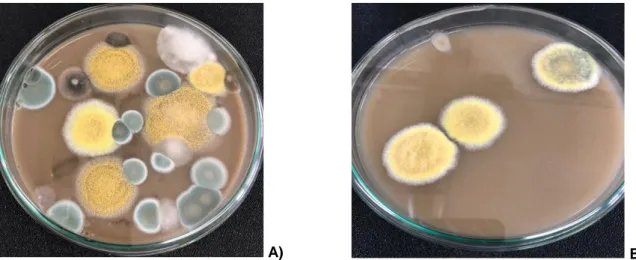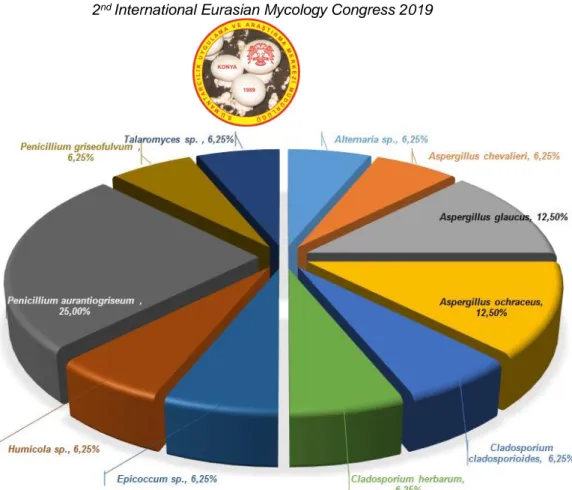MANTAR DERGİSİ/The Journal of Fungus Aralık(2019)10(özel sayı)60-66 2nd International Eurasian Mycology Congress 2019
60
Geliş(Recevied) :11/10/2019
Kabul(Accepted) :08/12/2019
Araştırma Makalesi/Research Article
Doi:10.30708.mantar.632181
Preliminary Study on the Determination of Heat Resistant Fungi
in Agricultural Soils
Suat SEZEN
1, Rasime DEMİREL
2**Corresponding Author: rasime.demirel@gmail.com
1Eskişehir Technical University, Graduate School of Sciences, Department of Biology, TR26470, Eskişehir
Orcid ID: 0000-0002-5901-5747/ suatsezen@eskisehir.edu.tr
2Eskişehir Technical University, Faculty of Science, Department of Biology, TR26470, Eskişehir Orcid ID: 0000-0001-6702-489X/rasime.demirel@gmail.com
Abstract: Heat resistant fungi are capable of surviving temperature at short heat
applications. These organisms continue to growing and metabolic activities. Therefore, they cause spoilage of food products and effect on health because of mycotoxin production. This study focused on determination of density and biodiversity of heat resistant fungi in agricultural soil samples. For this aim, two different soil samples were collected from agricultural lands at June 2018. Isolation process was performed by using main soil dilution method after heat treatment at 75°C for 30 minutes of diluted soil samples. After incubation at 25°C for 7-14 days, all colonies were purified. All of the isolates were diagnosed by using conventional methods according to the macromorphological and micromorphological properties. We determined 11 species belong to Alternaria, Aspergillus, Cladosporium, Epicoccum, Humicola, Penicillium and Taloromyces genera. As a result of this study, we showed that agricultural soil areas have a potential for heat resistance fungi biodiversity and exhibited that we should concentrate on this subject with investigation of different areas and sources.
Key words: Agricultural Soils, Heat Resistant Fungi, Conventional Method
Tarım Topraklarındaki Isıya Dirençli Fungusların Belirlenmesi
Üzerine Ön Çalışma
Öz: Isıya dayanıklı mantarlar, kısa ısı uygulamalarına dayanabilir. Bu organizmalar
büyümeye ve metabolik aktivitelere devam ederler. Bu nedenle, gıda ürünlerinde bozulmaya ve mikotoksin üretme yetenekleri sayesinde sağlık üzerinde etkiye neden olurlar. Bu çalışma, tarımsal toprak örneklerinde ısıya dirençli mantarların yoğunluğu ve biyolojik çeşitliliğinin belirlenmesi üzerine odaklanmıştır. Bu amaçla, Haziran 2018'de tarım alanlarından iki farklı toprak örneği toplanmıştır. İzolasyon işlemi dilüe edilmiş toprak örneklerinin 75 °C’de 30 dakika boyunca ısı uygulaması yapıldıktan sonra toprak dilüsyon yöntemi ile gerçekleştirilmiştir. 25 °C’de 7-14 günlük inkübasyondan sonra tüm koloniler saflaştırılmıştır. İzolatların tamamı makromorfolojik ve mikromorfolojik özelliklere göre geleneksel yöntemler kullanılarak teşhis edilmiştir. Alternaria, Aspergillus, Cladosporium, Epicoccum, Humicola, Penicillium ve Taloromyces cinslerine ait 11 tür tespit edilmiştir. Bu çalışma sonucunda, tarımsal toprak alanlarının ısıya dirençli mantar biyolojik çeşitliliği potansiyeline sahip olduğunu belirledik ve farklı alanların ve kaynakların araştırılmasıyla bu konuya odaklanmamız gerektiğini gösterdik.
61
Introduction
Soil; is a structure which physical and chemical properties including organic matter, minerals and large numbers of macro and microorganisms. This complex structure of the soil provides a suitable habitat for many microorganisms. The physicochemical structure of the soil, climate changes and agricultural applications have a significant impact on the biodiversity of soil (Chandrashekar et al., 2014).
Heat resistant fungi are microorganisms that resist short heat applications and whose main source is soil. These fungi are capable of surviving temperatures at or above 75°C for 30 or more minutes and can grow and cause spoilage during storage (Houbraken and Samson, 2006; Ali et al., 2009; Ibrahim et al., 2014). In addition to cause food spoilage, heat resistant fungi have direct
negative impact on human health because of mycotoxins, which are produced by these fungi (Demirci and Arıci, 2006).
Material and Method
Site Description and Soil Sampling
The sampling area is an agricultural land located within the latitude 39°59'43.14"N to 32°20'39.09"E coordinates and 3 km away from Ayaş district of Ankara (Figure 1). Typical continental climate characteristics are observed in the region. During the year, various agricultural crops such as barley are cultivated. Two soil samples were collected with a sterilized trowel from 5 profiles in 0–10 cm depth at June 2018. Samples were transported in sterile plastic bags and stored at +4°C until analysed.
A) B)
Figure 1. Photograph of the work area (A) and the location on the map (B)
Isolation
For isolation of the heat resistant fungi, 100 g of each soil sample was diluted in 150 ml sterilized distillate water in stomacher bag and homogenized by shaking. After homogenization, heat treat this stomacher bags at 75°C for 30 minutes in a water bath for inactivation of vegetative cells of fungi and bacteria. After the heat treatment, samples were cool to about 55°C. The contents of stomacher bag were transferred a sterile bottle (500 ml) and added 250 ml melted double strength Dichloran Glycerol Agar (DG18) medium. Sheerly mixed and poured into seven large petri dishes (diameter 12.0 mm). the petri dishes were incubated at 30°C for 7-14 days (Houbraken and Samson, 2006).
After incubation, colonies were counted and fungal number was calculated as CFU/g soil. Come into existence fungal colonies were subcultivated on Potato Dextrose Agar (PDA). Microscopic examination was
performed for the diagnosis of the genus level at the pure isolates that developed at 25°C incubation for 7 days.
Identification of isolates
Taxonomic identification of heat resistant fungi was evaluated according to their cultural characteristics and morphological structures. For identification of members of Aspergillus genus, inoculation process were performed on Malt Extract Agar (MEA), Czapek Yeast Extract Agar (CYA) (for 25 and 37°C), Creatine Sucrose Agar (CREA) media, incubated at 25°C for 7 days and investigated by using conventional method according to Klich (2002) and Samson et al. (2010). For members of Penicillium genus, MEA, CYA (for 25 and 30°C) and CREA media were used by incubation at 25°C for 7 days and investigated according to Samson et al. (2010). The other genera members were inoculated on PDA and MEA, incubated at
MANTAR DERGİSİ/The Journal of Fungus Aralık(2019)10(Özel Sayı)60-66 2nd International Eurasian Mycology Congress 2019
62
25°C for 7 days and investigated according to Barnet and Hunter (1999).
Result and discussion
The main objectives of this study were to determine the concentration and identification of heat resistant fungi in agricultural soil. Fungal counts and biodiversity in soil samples determined as 56 CFU/100 g soil (91.80 %) for sample A and 5 CFU/ 100 g soil (8.2 %) for sample B (Figure 2). The heat resistant fungi obtained in this study composed of 16 isolates belong to 7 genera that were encountered including Alternaria (1 species), Aspergillus (3), Cladosporium (2), Epicoccum (1), Humicola (1), Penicillium (2) and Talaromyces (1) according to their colony characteristics (Figure 3, 4). The highest fungal biodiversity was obtained from soil sample A as 75 %of total isolates (Table 1). The most common species belonged to the Aspergillus (3 species) genus and followed by Penicillium (2 species) and Cladosporium (2 species), respectively.
In this study, Aspergillus genus that attracts attention with widespread encounter is one of the most popular endophytic fungi. Endophytes live symbiotically in plants without causing significant diseases, involved in the biosynthesis of plant products and known as producer of many substances with potential use in the modern medicine, agriculture and pharmaceutical industry (Tawfik et al., 2017). Identified some members of Aspergillus genus as A. glaucus L. Link and A. ochraceus G. Wilh.commonly known as their mycotoxigenic properties
especially ochratoxin A producer (Valente et al., 2015; Moazam and Denning, 2017; Gil-Serna et al., 2018; Lim et al., 2019). In addition to some important members of Aspergillus genus, we determined 2 significant Penicillium genus members. One of them is P. aurantiogriseum Dierckx that causes contamination in foodstuffs such as olives, grains and especially on cereals (Bouhoudan et al., 2018; Neto et al., 2018). The other is P. griseofulvum Dierckx produces a mycotoxin named patulin which causes neurotoxicity, nephrotoxicity and hepatotoxicity (Benkerroum, 2016). Investigated soil samples were exhibited Cladosporium genus members rich profile. In previous studies, this genus was recorded as an important plant pathogen such as C. cladosporioides (Fresen.) G.A. de Vries (Nam et al., 2015) and mycotoxin producer and allergens such as C. herbarum (Pers.) Link (Hurrass et al., 2017, Sahib, 2019; Shuryak, 2019).
In addition to these common species, we obtained some isolates as Alternaria sp. that is pathogen on plant and human (Woudenberg et al., 2015; Patriarca, 2016; Tralamazza et al., 2018), Epicoccum sp. and Humicola sp. that known as important secondary metabolite (antioxidants, anticancers, and antimicrobial compounds) and bioactive compounds beside the saprophytic activities (Oliveira et al., 2018; Braga et al., 2018; Chadha et al., 2019; Wang et al., 2019), and Talaromyces sp. that is revised as new genus and include significant human pathogens (Chen et al., 2016).
A) B)
63
A) B)
Figure 3. Colony characteristics of isolates on CYA 25, CYA 37, MEA and CREA media (A) isolate A5 (B) isolate B3
Table 1. List of the isolates and identification result
Identification Result Number of the
Isolates Soil Sample
Alternaria Nees
1
AAspergillus chevalieri Thom & Church
1
AAspergillus glaucus L. Link
2
BAspergillus ochraceus G. Wilh.
2
ACladosporium cladosporioides (Fresen.) G.A. de Vries
1
ACladosporium herbarum (Pers.) Link
1
AEpicoccum Link
1
AHumicola Traaen
1
BPenicillium aurantiogriseum Dierckx
4
APenicillium griseofulvum Dierckx
1
ATalaromyces C.R. Benj.
1
BMANTAR DERGİSİ/The Journal of Fungus Aralık(2019)10(Özel Sayı)60-66 2nd International Eurasian Mycology Congress 2019
64
Figure.4. Fungal biodiversity together with annual average
A) B)
Figure 5. A) Humicola sp (100X), B) Epicoccum sp. (100X)
A) B)
65
Conclusion
As results of this preliminary study, species belonging to the Aspergillus and Penicillium genus were commonly found to be heat resistant fungi in the investigated farmland. In particular, the presence of saprophytic, pathogenic and mycotoxigenic members were evaluated as potential threat to agricultural products
and consumers. Our results shown that agricultural soils contain heat-resistant fungi on significant level and their metabolic effects may have significant effects on the life cycle. Therefore, the density and diversity of heat-resistant fungi in different sources should be detailed with new studies.
References
Ali, A.M., Moghazy, S., Shaban, G., El- Sababty Z. (2009). Heat-Resistant Fungi Isolated from Soil in Minia Governorate, Egypt, Assiut Univ. J. of Botany 38(2) 93-106
Barnett HL, Hunter BB, Illustrated Genera of Imperfect Fungi (1999), 4. Edition. 218 pp. APS Press, The American Phytopathological Society. St. Paul, Minnesota, USA,
Benkerroum, N. (2016). Mycotoxins in dairy products: a review. International dairy journal, 62, 63-75.
Bouhoudan, A., Chidi, F., Tantaoui-Elarak, A., & Khaddor, M. (2018). The effect of carbon source concentration on toxigenesis and lipase activity of Penicillium aurantiogriseum. Agriculture & Forestry/Poljoprivreda i Sumarstvo, 64(3). Braga, R. M., Padilla, G., & Araújo, W. L. (2018). The biotechnological potential of Epicoccum spp.: diversity of secondary
metabolites. Critical reviews in microbiology, 44(6), 759-778.
Chadha, B. S., Kaur, B., Basotra, N., Tsang, A., & Pandey, A. (2019). Thermostable xylanases from thermophilic fungi and bacteria: Current perspective. Bioresource technology.
Chandrashekar, M. A., Soumya, P., and Raju, N. S. (2014). Fungal diversity of rhizosphere soils in different agricultural fields of Nanjangud Taluk of Mysore District, Karnataka, India. Int. J. Curr. Microbiol. App. Sci, 3(5) 559-566.
Chen, A. J., Sun, B. D., Houbraken, J., Frisvad, J. C., Yilmaz, N., Zhou, Y. G., & Samson, R. A. (2016). New Talaromyces species from indoor environments in China. Studies in mycology, 84, 119-144.
Demirci, A.Ş. and Arici, M. (2006). Margarinde Yüksek Sıcaklığa Dayanıklı Küflerin Belirlenmesi ve Tanımlanması. Türkiye 9. Gıda Kongresi; 24-26. Tekirdağ.
Gil-Serna, J., Vázquez, C., González-Jaén, M., & Patiño, B. (2018). Wine contamination with ochratoxins: A Review. Beverages, 4(1), 6.
Houbraken, J. Samson, R.A. (2006). Standardization of methods for detecting heat resistant fungi. Advances in Experimental Medicine and Biology, 571, 107-111.
Hurrass, J., Heinzow, B., Aurbach, U., Bergmann, K. C., Bufe, A., Buzina, W., Heinz, W. (2017). Medical diagnostics for indoor mold exposure. International journal of hygiene and environmental health, 220(2), 305-328.
Ibrahim, S., Anusha, M.B., Udhayaraja, P. (2014). Isolation of heat resistant fungi from canned fruits. Golden Research Thoughts, 3(11) 1-10.
Klich, M. A. (2002). Identification of common Aspergillus Species, First edition, Utrecht, The Netherlands: Centraalbureau voor Schimmelcultures.
Lim, L., Senba, H., Kimura, Y., Yokota, S., Doi, M., Yoshida, K. I., & Takenaka, S. (2019). Influences of N-linked glycosylation on the biochemical properties of aspartic protease from Aspergillus glaucus MA0196. Process biochemistry, 79, 74-80.
Moazam, S., & Denning, D. W. (2017). Aspergillus nodules in chronic granulomatous disease attributable to Aspergillus ochraceus. Medical mycology case reports, 17, 31-33.
Nam, M. H., Park, M. S., Kim, H. S., Kim, T. I., & Kim, H. G. (2015). Cladosporium cladosporioides and C. tenuissimum cause blossom blight in strawberry in Korea. Mycobiology, 43(3), 354-359.
Neto, J. M. W. D., de Albuquerque Wanderley, M. C., de Albuquerque Lima, C., & Porto, A. L. F. (2018). Single step purification via magnetic nanoparticles of new broad pH active protease from Penicillium aurantiogriseum. Protein expression and purification, 147, 22-28.
Oliveira de, R. C., Carnielli-Queiroz, L., & Correa, B. (2018). Epicoccum sorghinum in food: occurrence, genetic aspects and tenuazonic acid production. Current Opinion in Food Science, 23, 44-48.
Patriarca, A. (2016). Alternaria in food products. Current Opinion in Food Science, 11, 1-9.
Sahib, R. A. (2019). The Effects of Toxic Compounds of Cladosporium herbarum on Hormones of Female Rats and Ability of Ascorbic Acid to Decrease Growth of C. herbarum. Journal of Pharmaceutical Sciences and Research, 11(3), 1136-1139.
Samson, R.A, Houbraken, J., Thrane, U., Frisvad, J.C. Andersen, B. (2010). Food and indoor fungi, Utrecht, The Netherlands: CBS KNAW Fungal Diversity Centre.
Shuryak, I. (2019). Review of microbial resistance to chronic ionizing radiation exposure under environmental conditions. Journal of environmental radioactivity, 196, 50-63.
MANTAR DERGİSİ/The Journal of Fungus Aralık(2019)10(Özel Sayı)60-66 2nd International Eurasian Mycology Congress 2019
66
Tawfik, N. F., Tawfike, Ů., Abdo, R., Abbott, G., Abdelmohsen, U., Edrada-Ebel, R., & Haggag, E. (2017). Metabolomics and Dereplication Study of the Endophytic Fungus Aspergillus chevelieri in Search of Bioactive Natural Compounds. Journal of Advanced Pharmacy Research, 1(2), 100-109.
Tralamazza, S. M., Piacentini, K. C., Iwase, C. H. T., & de Oliveira Rocha, L. (2018). Toxigenic Alternaria species: impact in cereals worldwide. Current Opinion in Food Science, 23, 57-63.
Valente, V. M. M., Jham, G. N., Jardim, C. M., Dhingra, O. D., & Ghiviriga, I. (2015). Major Antifungals in Nutmeg Essential Oil against Aspergillus flavus and A. ochraceus. Journal of Food Research, 4(1), 51.
Wang, X. W., Yang, F. Y., Meijer, M., Kraak, B., Sun, B. D., Jiang, Y. L., ... & Samson, R. A. (2019). Redefining Humicola sensu stricto and related genera in the Chaetomiaceae. Studies in mycology, 93, 65-153.
Woudenberg, J. H. C., Seidl, M. F., Groenewald, J. Z., De Vries, M., Stielow, J. B., Thomma, B. P. H. J., & Crous, P. W. (2015). Alternaria section Alternaria: Species, formae speciales or pathotypes?. Studies in Mycology, 82, 1-21.



